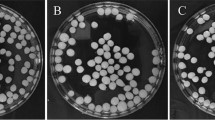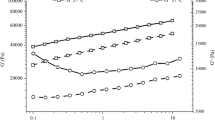Abstract
Effect of PEG-mediated pore forming on Ca-alginate immobilization of nitrilase-producing bacteria Pseudomonas putida XY4 was studied. Through using PEG as porogen, the environmental tolerance as well as the biocatalytic reaction efficiency of immobilized cells was greatly improved, i.e., Ca-alginate-PEG immobilized cells got better temperature and substrate concentration tolerance than Ca-alginate immobilized cells and showed similar efficiency with free cells, suggesting that the intrinsic mass transfer resistance of immobilization obviously decreased. It was also observed that the pore diameter and porosity of immobilization beads were related with the molecular weight of PEG. PEG400 was found to be a relatively suitable porogen for Ca-alginate-PEG immobilized cells catalyzed hydrolysis of glycinonitrile. It was noteworthy that the Ca-alginate-PEG immobilized cells could be reused more than 18 times with little loss of enzyme activity which had shown good operation ability and great application potential.





Similar content being viewed by others
References
D’Antona N, Morrone R (2011) Biocatalysis: green transformations of nitrile function. In: Sanjay KS, Ackmez M (eds) Green Chemistry for Environmental Sustainability. CRC Press, Baco Raton
Martinkova L, Mylerova V (2003) Synthetic applications of nitrile-converting enzymes. Curr Org Chem 7:1279–1295
Kumar S, Mohan U, Kamble A, Pawar S, Banerjee U (2010) Cross-linked enzyme aggregates of recombinant Pseudomonas putida nitrilase for enantioselective nitrile hydrolysis. Bioresour Technol 101:6856–6858
Vejvoda V, Kaplan O, Bezouška K, Pompach P, Šulc M, Cantarella M, Benada O, Uhnáková B, Rinágelová A, Lutz-Wahl S, Fischer L, Křen V, Martínková L (2008) Purification and characterization of a nitrilase from Fusarium solani O1. J Mol Catal B Enzym 50:99–106
Kaul P, Banerjee A, Banerjee UC (2006) Stereoselective nitrile hydrolysis by immobilized whole-cell biocatalyst. Biomacromolecules 7:1536–1541
Chen J, Zheng YG, Shen YC (2008) Biosynthesis of p-methoxyphenylacetic acid from p-methoxyphenylacetonitrile by immobilized Bacillus subtilis ZJB-063. Process Biochem 43:978–983
Kabaivanova L, Dobreva E, Dimitrov P, Emanuilova E (2005) Immobilization of cells with nitrilase activity from a thermophilic bacterial strain. J Ind Microb Biotechnol 32:7–11
Bauer A, Layh N, Syldatk C, Willetts A (1996) Polyvinyl alcohol-immobilized whole-cell preparations for the biotransformation of nitriles. Biotechnol Lett 18:343–348
Vekova J, Pavlu L, Vosahlo J, Gabriel J (1995) Degradation of bromoxynil by resting and immobilized cells of Agrobacterium radiobacter 8/4 strain. Biotechnol Lett 17:449–452
Graham D, Pereira R, Barfield D, Cowan D (2000) Nitrile biotransformations using free and immobilized cells of a thermophilic Bacillus spp. Enzyme Microb Technol 26:368–373
Nagashima R, Hirose H, Matsuyama H (2011) Immobilization of microorganisms within porous polymeric capsules. J Appl Polym Sci 121:321–326
Fawcett JK, Scott JE (1960) A rapid and precise method for the determination of urea. J Clin Pathol 13:156–159
Tuemtuerk H, Sahin F, Demirel G (2007) A new method for immobilization of acetylcholinesterase. Bioprocess Biosyst Eng 30:141–145
Acknowledgments
This work was supported by the Natural Science Foundation of Jiangsu Province (BK2011186), the Fundamental Research Funds for the Central Universities (JUSRP11134, JUSRP211A44).
Author information
Authors and Affiliations
Corresponding authors
Rights and permissions
About this article
Cite this article
Cheng, Y., Ma, L., Deng, C. et al. Effect of PEG-mediated pore forming on Ca-alginate immobilization of nitrilase-producing bacteria Pseudomonas putida XY4 . Bioprocess Biosyst Eng 37, 1653–1658 (2014). https://doi.org/10.1007/s00449-014-1137-1
Received:
Accepted:
Published:
Issue Date:
DOI: https://doi.org/10.1007/s00449-014-1137-1




